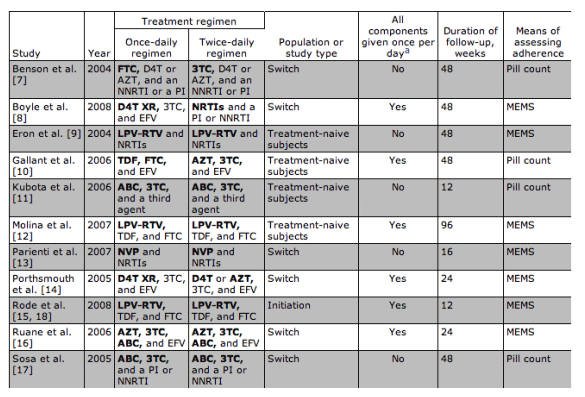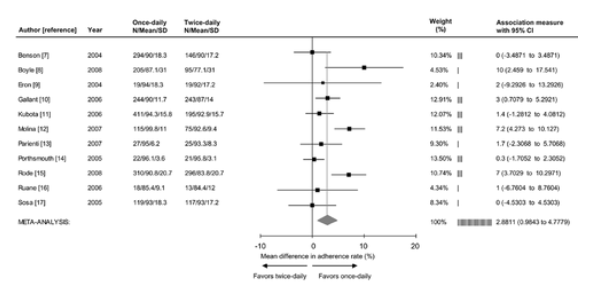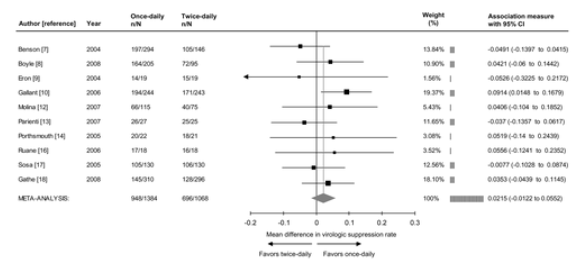| |
Once-Daily HAART Modestly Beats Twice-Daily on Adherence & Viral Suppression: meta-analysis
|
| |
| |
"Our meta-analysis found that the rate of adherence to once-daily antiretroviral regimens was better (+2.9%) than the rate of adherence to twice-daily regimens. To our knowledge, this is the first attempt to quantify, in a meta-analysis, the effect of dosing schedule on adherence to antiretroviral therapy. This effect was greater for patients who were initiating treatment than for those receiving stable therapy who were observed in "switch" studies."
"Among the 5 trials of treatment-naive subjects [9-12, 15] (1927 patients), use of once-daily regimens significantly improved adherence (+4.4%; 95% CI, 1.8%-7.0%; p<.001) and was associated with better virologic outcome (+5.7%; 95% CI, 0.7%-10.8%; p<.027). In contrast, among the 6 trials [7, 8, 13, 14, 16, 17] that involved treatment-experienced subjects (1102 patients), the adherence effect size was not statistically significant (+1.0%; 95% CI, -0.8 to 2.8; p=.29) and did not correspond to better virologic outcome (-0.7%; 95% CI, -5.2 to 3.8; p=.76)."--"Six studies [8, 10, 12, 14-16] investigated (1657 patients) a regimen that consisted entirely of medications with once-daily administration. In this subgroup, use of the once-daily regimens were associated with significantly improved adherence (+4.5%; 95% CI, 1.5%-7.5%; p<.004) and better virologic outcome (+5.7%; 95% CI, 1.4%-10.0%; p<.001). In contrast, in the 5 trials [7, 9, 11, 13, 17] (1372 patients) in which regimens with once-daily and twice-daily components were mixed, the adherence effect size was not significant (+0.9%; 95% CI -0.8% to 2.6%; p=.29), and treatment did not correspond with a better virologic outcome (-3.3%; 95% CI, -8.6% to 2.1%; p=.23)."
"There was also a difference in the rates of viral suppression that favored studies in which all medications were administered as a once-daily regimen. Administration of the entire regimen once per day may have led to better regimen adherence (and not just to the monitored medicine), leading to better virologic outcomes, than in regimens with more complicated dosing schedules."
"The availability of once-daily combination antiretroviral regimens represents a considerable advancement, which has been welcomed by patients [23]. On the basis of our findings, we conclude that once-daily dosing improved adherence, particularly at treatment initiation and if all of the medications were administered once per day. Furthermore, these effects were compatible with better virologic outcome in selected subgroups. However, physicians should be aware that the objective impact of once-daily versus twice-daily dosing on adherence rates is modest. Because adherence to medication regimens is a complex behavior with multiple factors at play, efforts to improve adherence should not be restricted to prescription of once-daily medications [24, 25]. Other factors, including tolerability, potency, and potential risk of resistance, given the patient's individual adherence pattern, are important considerations in selecting the optimal regimen for each patient."
Better Adherence with once-daily Antiretroviral Regimens: A Meta-Analysis
Clinical Infectious Diseases Feb 15 2009;48:484-488
Jean-Jacques Parienti,1,2,3,4 David R. Bangsberg,5 Renaud Verdon,2 and Edward M. Gardner6
Departments of 1Biostatistics and Clinical Research and 2Infectious Diseases, Cote de Nacre University Hospital, Caen, and 3Pierre et Marie Curie University, and 4INSERM U707, Paris, France; 5Partners AIDS Research Center, Massachusetts General Hospital, Harvard Medical School, Boston; and 6Public Health Department, Denver Health and Hospital Authority, Denver, Colorado
ABSTRACT:
-once-daily regimens of antiretroviral therapy are simpler than other regimens, but whether such regimens are associated with better adherence to treatment is controversial. We performed a meta-analysis of 11 randomized, controlled trials (total number of subjects, 3029), which revealed that the adherence rate was better with once-daily regimens (+2.9%; 95% confidence interval, 1.0%-4.8%; p<.003) than with twice-daily regimens. This modest effect was more pronounced at the time of treatment initiation and for regimens for which all medications were taken once per day.
Poor adherence to antiretroviral therapy increases the risk of incomplete viral suppression, disease progression, and death [1-3]. There has been important progress over the past decade in simplifying dosing frequency and pill burden [4]. Regimens have evolved from those involving administration of >25 pills 3 times per day to those involving 1 pill administered every day. Although some studies have found no difference in adherence rates for once-daily (quaque die in Latin) versus twice-daily (bis in die in Latin) regimens, the statistical power of these studies has generally been low. To synthesize existing data across studies, we conducted a meta-analysis that compared adherence and virologic suppression rates in patients receiving once-daily versus twice-daily regimens in randomized, controlled trials.
Discussion.
Our meta-analysis found that the rate of adherence to once-daily antiretroviral regimens was better (+2.9%) than the rate of adherence to twice-daily regimens. To our knowledge, this is the first attempt to quantify, in a meta-analysis, the effect of dosing schedule on adherence to antiretroviral therapy. This effect was greater for patients who were initiating treatment than for those receiving stable therapy who were observed in "switch" studies. The smaller effect among recipients of stable treatment may be related to selection bias toward more-highly adherent patients in these studies, because all studies required an undetectable viral load before enrollment. Publication bias (i.e., the tendency for negative or inconclusive results to remain hidden and unpublished) was not likely for the primary end point, because the reporting of similar adherence rates between arms increases the internal validity of efficacy results. Random allocation of the dosing schedule and the use of objective measurements further support the internal validity of the adherence effect size estimate.
Although it was statistically significant, the 2.9% difference in adherence between once-daily and twice-daily regimens was modest. This difference in adherence did not correspond to an overall difference in rates of viral suppression among all studies. However, similar to the primary analysis of adherence, there was a difference in the rates of viral suppression that favored studies involving antiretroviral-naive patients over switch studies. Antiretroviral-naive patients may be more sensitive to differences in adherence because of lower rates of preexisting drug resistance. Furthermore, the association between adherence and viral suppression is likely to be more critical when rates of viral replication are high, such as at the time of initiation of a first antiretroviral regimen. There was also a difference in the rates of viral suppression that favored studies in which all medications were administered as a once-daily regimen. Administration of the entire regimen once per day may have led to better regimen adherence (and not just to the monitored medicine), leading to better virologic outcomes, than in regimens with more complicated dosing schedules.
Improvements in treatment adherence for once-daily versus twice-daily regimens in switch studies were marginal and statistically nonsignificant. However, because the switch studies reviewed here required subjects to have an undetectable viral load, it is unclear whether simplification from twice-daily to once-daily regimens would improve adherence to a greater extent in less-adherent patients. Among individuals with viral suppression, switches in the reverse direction (from once-daily to twice-daily regimens) are sometimes necessary for management of toxicities. These data suggest that a switch from once-daily to twice-daily treatment regimens may not result in adherence problems or loss of virologic efficacy.
There are several limitations to our study. The differences we observed could have been due to the drugs themselves, rather than how often they were taken each day. Most studies had relatively short follow-up periods and recruited patients who were highly adherent to treatment in clinical trial settings. The impact of dosing frequency on adherence and virologic outcome may differ in less-adherent populations found in routine clinical practice. The effect of dosing frequency may also be different with longer follow-up periods, because adherence wanes over time [19, 20]. Finally, because only the adherence rate for the once-daily or twice-daily regimen component was measured, the potential for differential drug exposure, which increases the risk of resistance [21, 22], was not evaluated.
The availability of once-daily combination antiretroviral regimens represents a considerable advancement, which has been welcomed by patients [23]. On the basis of our findings, we conclude that once-daily dosing improved adherence, particularly at treatment initiation and if all of the medications were administered once per day. Furthermore, these effects were compatible with better virologic outcome in selected subgroups. However, physicians should be aware that the objective impact of once-daily versus twice-daily dosing on adherence rates is modest. Because adherence to medication regimens is a complex behavior with multiple factors at play, efforts to improve adherence should not be restricted to prescription of once-daily medications [24, 25]. Other factors, including tolerability, potency, and potential risk of resistance, given the patient's individual adherence pattern, are important considerations in selecting the optimal regimen for each patient.
Methods.
J.-J.P. and E.M.G. conducted searches of the PubMed database and recent HIV science conferences, both independently and in duplicate, to identify open-label, randomized, controlled trials that compared once-daily and twice-daily antiretroviral regimens given to HIV-1-infected subjects. A flow chart of the study is available from the authors. The once-daily regimens could contain twice-daily components, so long as adherence to the once-daily component was reported.
Because self-reported adherence may involve perceptions of perceived adherence efficacy that do not necessarily reflect adherence itself, we limited our review to studies that included pill counts or Medication Event Monitoring System [MEMS] measurements. The primary end point was the mean adherence rate, which was defined as follows: (total number of doses, taken/total, number of doses, prescribed) x 100. The secondary end point was the percentage of subjects with HIV-1 RNA levels <50 copies/mL in the intent-to-treat, missing-equals-failure analysis. This data set was chosen for homogeneity, because it was consistently reported across the trials.
To compute effect sizes when data were incomplete, the following strategy was implemented: (1) contact the corresponding author; (2) estimate the SD on the basis of the sample size, median, and range [5] or on the basis of the sample size and P value; and (3) impute the SD reported in similar studies.
We used the mean weighted difference and 95% CI to assess adherence to treatment and the virologic control effect of once-daily versus twice-daily antiretroviral therapy regimens. A positive value indicated better adherence or virologic control for the once-daily antiretroviral regimen. DerSimonian and Laird random effects models were used to synthesize results across studies. A random effects model is based on the assumption that there is no "true" effect but, rather, a stochastic distribution of effects that produced the empirical values of the studies. These models are indicated if variations in sampling schemes could introduce heterogeneity to the result-in other words, if there is >1 intercept in the solution. The robustness of the overall primary end point result was assessed by exclusion sensitivity analysis.
Heterogeneity was assessed using the Cochran's Q test. This statistic was complemented with I2, which is the percentage of total variation across studies that is due to heterogeneity rather than chance. With consistent study results, the I2 equals 0. Publication bias was assessed using Eggers' statistical test. Additional analyses were conducted to explore the reasons for heterogeneity in subgroup analyses, including (1) studies that included treatment-naive individuals initiating their first regimens of antiretroviral therapy versus those that included individuals with virologic suppression who entered a treatment-switch trial (prespecified before data collection), and (2) studies of regimens for which all components were administered once per day versus those with at least 1 twice-daily component (post-hoc). Statistical analysis was conducted with MIX software [6], and P values <.05 were considered to be statistically significant.
Results.
Eleven studies [7-17], which included a total of 3029 subjects, were included in our meta-analysis. Descriptive data for each trial are provided in table 1. There was no evidence of publication bias (intercept, 0.8; 95% CI, -2.2 to 3.7; p=.58 , by Eggers' test) regarding the primary end point.
Table1. Characteristics of studies included in a meta_analysis of once_daily vs. twice_daily antiretroviral therapy regimens.

The meta-analysis revealed significantly better adherence (+2.9%; 95% CI, 1.0%-4.8%; p<.003) among recipients of once-daily regimens, compared with recipients of twice-daily regimens (figure 1). Better adherence to once-daily versus twice-daily regimens remained statistically significant in all 11 sensitivity analyses conducted, after we excluded 1 individual study (data not shown). Ten studies [7-10, 12-14, 16-18], which represented 2452 subjects, reported virologic end points. The meta-analysis found no significant difference in the proportion of subjects who achieved HIV RNA levels <50 copies/mL (+2.2%; 95% CI -1.2 to 5.5; p=.21) between recipients of once-daily versus twice-daily regimens (figure 2).
Figure1. Forrest plot of the effect of once-daily versus twice-daily antiretroviral regimens on the rate of adherence. Adherence rate was defined as follows: (no. of taken doses/no. prescribed doses) x 100. Cochrane Q test for heterogeneity: X2=29.7; degrees of freedom, 10; p=<.001; I2 =66.4%. Test for overall random effect: Z=2.98 ; p<.003 .

Figure2. Forrest plot of the effect of once-daily versus twice-daily antiretroviral regimens on viral suppression. Viral suppression was defined as a plasma RNA HIV level <50 copies/mL in the intent-to-treat analysis, with missing equals failure. In the study by Gathe et al. [18], data represent week 12 results among subjects with Medication Event Monitoring System evaluation (Dr. Rode, personal communication, December 2008). Week 48 results are 77% and 76% for once-daily and twice-daily regimens, respectively. Cochrane Q test for heterogeneity: X2=8.2; degrees of freedom, 9; p=.43; I2=0.0%. Test for overall random effect: Z=1.25 ; P=.21 . n, No. of subjects with viral suppression; N, total sample size.

Significant quantitative heterogeneity (I2=66.4%; 95% CI, 36.4-82.2) of the adherence effect size was explored in subgroup analyses. Among the 5 trials of treatment-naive subjects [9-12, 15] (1927 patients), use of once-daily regimens significantly improved adherence (+4.4%; 95% CI, 1.8%-7.0%; p<.001) and was associated with better virologic outcome (+5.7%; 95% CI, 0.7%-10.8%; p<.027). In contrast, among the 6 trials [7, 8, 13, 14, 16, 17] that involved treatment-experienced subjects (1102 patients), the adherence effect size was not statistically significant (+1.0%; 95% CI, -0.8 to 2.8; p=.29) and did not correspond to better virologic outcome (-0.7%; 95% CI, -5.2 to 3.8; p=.76).
Six studies [8, 10, 12, 14-16] investigated (1657 patients) a regimen that consisted entirely of medications with once-daily administration. In this subgroup, use of the once-daily regimens were associated with significantly improved adherence (+4.5%; 95% CI, 1.5%-7.5%; p<.004) and better virologic outcome (+5.7%; 95% CI, 1.4%-10.0%; p<.001). In contrast, in the 5 trials [7, 9, 11, 13, 17] (1372 patients) in which regimens with once-daily and twice-daily components were mixed, the adherence effect size was not significant (+0.9%; 95% CI -0.8% to 2.6%; p=.29), and treatment did not correspond with a better virologic outcome (-3.3%; 95% CI, -8.6% to 2.1%; p=.23).
|
|
| |
| |
|
|
|